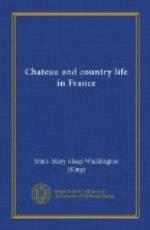We breakfasted in a large square dining-room running straight through the house, windows on each side. The room was all in wood panelling—light gray—the sun streaming in through the windows. Mme. de Courval put W. on her right, me on her other side. We had an excellent breakfast, which we appreciated after our early start. There was handsome old silver on the table and sideboard, which is a rare thing in France, as almost all the silver was melted during the Revolution. Both Mme. de Courval and her daughter were very easy and animated. The Marquise de Chaponay told me she had known W. for years, that in the old days before he became such a busy man and so engrossed in politics he used to read Alfred de Musset to her, in her atelier, while she painted. She supposed he read now to me—which he certainly never did—as he always told me he hated reading aloud. They talked politics, of course, but their opinions were the classic Faubourg St. Germain opinions: “A Republic totally unfitted for France and the French”—“none of the gentlemen in France really Republican at heart” (with evidently a few exceptions)—W.’s English blood and education having, of course, influenced him.
As soon as breakfast was over one of the windows on the side of the moat was opened and we all gave bread to the carp, handed to us by the butler—small square pieces of bread in a straw basket. It was funny to see the fish appear as soon as the window was opened—some of them were enormous and very old. It seems they live to a great age; a guardian of the Palace at Fontainebleau always shows one to tourists, who is supposed to have been fed by the Emperor Napoleon. Those of Pinon knew all about it, lifting their brown heads out of the water and never missing their piece of bread.
We went back to the drawing-room for coffee, passing through the billiard room, where there are some good pictures. A fine life-size portrait of General Moreau (father of Mme. de Courval) in uniform, by Gerard—near it a trophy of four flags—Austrian, Saxon, Bavarian, and Hungarian—taken by the General; over the trophy three or four “lames d’honneur” (presentation swords) with name and inscription. There are also some pretty women’s portraits in pastel—very delicate colours in old-fashioned oval frames—quite charming.
The drawing-room was a very handsome room also panelled in light gray carved wood; the furniture rather heavy and massive, curtains and coverings of thick, bright flowered velvet, but it looked suitable in that high old-fashioned room—light modern furniture would have been out of place.
As soon as we had finished our coffee we went for a walk—not the two old ladies, who settled down at once to their embroidery frames; one of them showed me her work—really quite beautiful—a church ornament of some kind, a painted Madonna on a ground of white satin; she was covering the whole ground with heavy gold embroidery, so thick it looked like mosaic.




